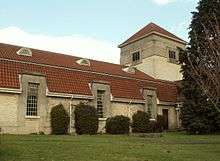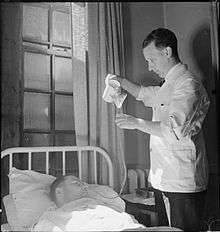Runwell Hospital
| Runwell Hospital | |
|---|---|
| South Essex Partnership University NHS Foundation Trust | |
 Providing Services That Are Intune With You | |
| Geography | |
| Location | Wickford, Essex, England, United Kingdom |
| Organisation | |
| Care system | Public NHS |
| Hospital type | Psychiatric |
| Affiliated university | Anglia Ruskin University |
| Services | |
| Emergency department | No Accident & Emergency |
| Beds | max 800, 2007 200, 2009 76 |
| History | |
| Founded | 1937 |
| Closed | November 2nd 2009 (Wards); April 2010 Final Close Down |
| Links | |
| Website | http://www.sept.nhs.uk |
| Lists | Hospitals in England |
Runwell Hospital was a hospital in Essex operated by South Essex Partnership University NHS Foundation Trust until its final closure on 23 April 2010. From February 2008 until its closure, Runwell Hospital provided solely forensic mental health services in line with the trust's reprovision programme. The closure has led to some services being reprovided at Rochford Hospital.
Runwell Hospital was approximately 30 miles (50 km) east of London and could be reached via the road network, or by train (taking about 40 minutes). Runwell Hospital fell within the District of Chelmsford along with Springfield and South Woodham Ferrers.
History

Following the ending of contracts accommodating patients at the Essex County Council's Brentwood mental hospital, joint facilities were developed between East Ham and Southend-on-Sea boroughs. A site was chosen at Runwell Hall Farm, to the east of the town of Wickford and the firm of Elcock and Sutcliffe were chosen as architects to the site, the former having previously designed the new Bethlem Royal Hospital at Monks Orchard. Elcock and Sutcliffe were at the forefront of institutional design and when completed, Runwell was seen as being pioneering development in mental hospital compared to its contemporaries. The hospital opened in June 1937.
The hospital was divided into specific zones according to purpose and type of patient. Staff housing was located close to or outside of the main entrance, with the most senior residences and nurse's home located on the main drive. The chapel, dedicated to St. Luke was placed at the principal junction at the top of the drive - to its east lay admission, research, treatment convalescence and neurosis blocks. The main buildings were laid out to the west: villas for working patients, pavilions for the infirm, administrative buildings, recreation hall, kitchens, and stores blocks providing segregation of male and female blocks. Workshops were provided on either side for the employment of capable patients. To the rear a combined power house and water tower provided a central focal point, with the laundry constructed on the female side. Parole villas were built at the northernmost areas behind the main ranges, providing a degree of freedom to suitable occupants. A large sick hospital was provided directly opposite the administrative block, combining wards for physically sick patients, those with tuberculosis, an operating theatre and staff sick bay. Finally, farthest west, Boundary House, a large block for disruptive chronic patients was built, providing two male wards, four female wards and a separate dining hall. The former farm was relocated to the north of the main site.
Unlike others of its kind, Runwell utilised names for all villas and wards from the start, instead of numbers and letters used elsewhere until the 1960s and 70's, giving each structure a more homely identity. White with grey brick banding, rendering and variation between flat and pitched roofs were used to identify buildings and prevent a bland functional appearance overall by providing variety.
Following World War II, Runwell came under the control of the National Health Service, who continued pioneering research work at the hospital. New developments included the Strom Olsen ward, adjacent to the female admission unit, and named after a former superintendent, and a combined occupational therapy and research laboratory block. Investigations under Professor Corsellis led to the development of a 'brain bank', the largest of its kind and instrumental in researching changes to the brain in mental illness and subnormality.
Under sectorisation and realignment of catchment areas, Runwell's historical role in providing for East Ham diminished and services became concentrated on the south east Essex area, resulting in strong links with mental health services at Southend Municipal Hospital, later Rochford Hospital. With the threat of closure and development of Care in the Community, services were streamlined between Runwell and Rochford sites, the laboratories and peripheral buildings closing.
Ward names of the 1970s
- Ambleside - Female Admissions
- Boleyn One - Female
- Boleyn Two - Female
- Brookside Ward - Female Long Stay
- Chalkwell One - Female Elderly
- Chalkwell Two - Female Elderly
- Elizabeth Ward - Female Geriatric
- Elm House - Male Geriatric
- Glendale Ward - Male Admissions
- Grangewood One - Male
- Grangewood Two - Male
- Female Harper One
- Female Harper Two
- Male Harper One
- Male Harper Two
- Harper Unit - Theatre's, Dentist etc.
- Hillview Ward - Female
- Laburnum Ward - Female Geriatric
- Leigh House - Female
- Margaret Ward - Female Geriatric
- Nightingale Ward - Female Geriatric
- Oakfield Ward - Male
- Plashet One - Male Geriatric
- Plashet Two - Female Locked Ward
- Rettendon Ward - Male
- Sandringham Ward - Male Long Stay
- Sherrington Ward - Female Locked Ward
- Strom Olsen - Female
- Sunnyside Ward - Female Long Stay
- Westcliff Ward - Female Admissions
- Windsor Ward - Male Long Stay
- Woodside Ward - Male Long Stay
Ward names of the 2000s
- Ashingdon Ward - Demountable Building opened in 2004 closed in 2008
- Belfairs Ward - Psychiatric Intensive Care Unit (Closed 2007)
- Belfairs Ward - Medium Secure Female Admissions and Rehab
- Boleyn One - Acute Mental Health
- Chalkwell One - Acute Mental Health
- Dove Ward - Rehab (Opened 2005 - Closed 2009)
- Elm House - ElderlyFairview Ward - Medim Secure Forensic Male Rehab (Admitted Females Until 2007)
- Harman Ward - Medium Secure Forensic Pre Discharge
- Heron Ward - Continuing Care (Closed 2005)
- Hullbridge Ward - Medium Secure Forensic Male Admissions (admitted females until 2007)
- Laburnum Ward - Acute Mental Health (Closed 2006)
- Oakview Ward - Low Secure Male Admissions (Opened 2005)
- Plashet Ward - Medium Secure Forensic Male Rehab (Admitted Females Until 2007)
- Steepleview Ward - Low Secure Male and Female Rehab
- Westcliff Ward - Continuing Care (Closed 2005)
- Wren Ward - Continuing Care (Closed 2005)
Ward moves and renames
- Female Harper One amalgamated with Female Harper Two and renamed Wren Ward then again renamed Steepleview Ward
- Male Harper One amalgamated with Male Harper Two and renamed Heron Ward then again Dove Ward
- Harper Unit offices converted to Newham Ward then renamed Harman Ward then again renamed Oakview Ward
- Grangewood One - Renamed Steepleview Ward then again renamed Fairview Ward
- Grangewood Two - Renamed Plashet Three then again renamed Belfairs Ward
- Plashet Two - Renamed Hullbridge Ward
- Westcliff Ward - Renamed Harman Ward
Important dates
- 1934 Building work commences
- 1936 First patients admitted
- 1937 Runwell Mental Hospital opens with 1,032 beds
- 1948 Joined the National Health Service
- 1950 Dr Corsellis starts the Corsellis Brain Collection
- 1955 Renamed Runwell Hospital
- 1979 Beds have steadily reduced to 849
- 1987 Runwell Hospital celebrates 50 years since opening
- 1993 Corsellis collection amounts to 8000 brains
- 1999 Southend Community Care NHS Trusts begins reprovision plans for final closure of Runwell
- 1996 Wren Ward (female) and Boleyn Two close and almagamate to Mountnessing Court in Billericay
- 1996 New Wren Ward (male) opens
- 2003 Newham Ward Closed and disbanded reduction of 7 beds
- 2003 The Lodge undergoes major refurbishment of all four floors
- 2003 Harman Ward Opens in extensively refurbished Newham Ward building increasing by 7 beds
- 2003 Past Times, Patient canteen is closed and relocated into the main administration building
- 2004 Ashingdon ward is relocated to Runwell Hospital into a temporary demountable ward from Rochford Hospital increasing by 28 beds
- 2005 Construction of new Rochford Hospital commences
- 2005 Wren Ward closes and amalgamate with Heron Ward to create Dove Ward reduction of 12 beds
- 2005 Steepleview Ward relocates to Wren ward building, after extensive refurbishment
- 2005 Laburnum Ward Closed and disbanded reduction of 23 beds
- 2005 Staff House Road demolished in preparation for new hospital construction
- 2005 Fairview Ward Opens after refurbishment of old Steepleview Ward increase by 10 beds
- 2005 Westcliff Ward Closes reduction of 10 beds
- 2005 Harman Ward relocates into old Westlcliff Ward building after major refurbishment, moving 7 beds
- 2005 Oakview Ward Opens in old Harman Ward building increase by 7 beds
- 2006 Laburnum Ward used as a temporary base whilst Westley Ward, Basildon Mental Health Unit undergoes refurbishment
- 2006 Laburnum Ward again used as a temporary ward whilst Heath Close Learning Disability ward undergoes refurbishment
- 2006 Ceiling collapses in Main Hall
- 2006 Laburnum ward closed and disbanded
- 2007 Head office relocates to the Lodge, Runwell Hospital from Dunton Court, Laindon, Essex
- 2007 Belfairs Ward relocated to Basildon Hospital reduction of 10 beds
- 2007 New Belfairs Women's Ward opens in refurbished Belfairs ward increase by 10 beds
- 2007 Construction begins on new hospital
- 2008 Ashingdon Ward, Boleyn One Ward, Chalkwell Ward and Elm Ward are relocated to the new Rochford Hospital and renamed Ashingdon Ward is now Maple Ward, Boleyn One Ward is now Cedar Ward, Chalkwell Ward is now Willow Ward and Elm Ward is now Beech Ward, reduction and permanent closure of 96 beds
- 2008 Dove Ward closed and disbanded, reduction and permanent closure of 15 beds
- 2008 65 beds remain at Runwell Hospital
- 2009 Demountable Ashingdon Ward is removed from Runwell Hospital site and relocated to Thurrock Hospital
- 2009 The Lodge, Head office undergoes Major refurbishement
- 2009 Official naming of the new hospital development, Brockfield House
- 2009 Official Completion and handover of Brockfield House, the new £28 million, 96 bed Forensic Mental Health Hospital
- 2009 Official opening of Brockfield House, prior to patient use due to security reasons
- 2009 Relocation of Belfairs Ward, Fairview Ward, Harman Ward, Hullbridge Ward, Oakview Ward, Plashet Ward and Steepleview Ward to Brockfield House, all wards will be renamed as part of this process and Runwell Hospital buildings secured.
- 2009 All wards at Brockfield house operational, Belfairs Ward is now Fuji, Fairview Ward is now Forest, Harman Ward is now Aurora, Hullbridge Ward is now Alpine, Oakview Ward is now Dune, Plashet Ward is now Lagoon and Steepleview Ward is now Causeway.
- 2009/10 Proposed final closure and decommissioning of Runwell Hospital - final few departments to be moved from the existing Runwell Hospital site
- 2010 February 26, heating system closed down and reception closed
- 2010 April 23, Runwell undergoes its final closure, all staff move out
- 2010 Fences are placed on the access route into the Runwell grounds and patrolled by security
Since Closure
It was announced on Tuesday 27 April 2009 in Parliament by the Jack Straw, Ministry of Justice, that the Runwell Hospital site had been earmarked for a new 1,500-inmate male prison but the plan was formally withdrawn following a Ministry of Justice spending review in December 2010.
In February 2012, the Homes & Communities Agency (H.C.A.) announced plans to construct around 600 new homes on the site.
Demolition started in July 2012 and the only buildings to remain will be: the administration building (front part with clock tower), the water tower, and the Grade 2 Listed Chapel of Saint Luke.
External links
Coordinates: 51°38′07″N 0°32′30″E / 51.6352°N 0.5418°E